Reading, Writing, & Thinking: Cross-Curricular Literacy Initiatives
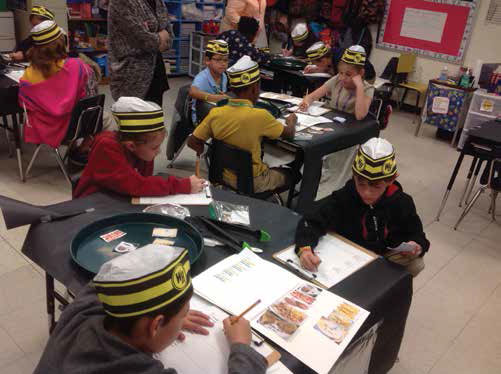
Innovative educators know that students preparing for the challenges of work and further study in our ever-changing world need to achieve fluency and comprehension—but they also need to develop higher-level thinking skills and build deep knowledge. The following schools and districts are using edtech tools to integrate literacy skills across the curricula.
LESSONS OUTSIDE THE BOX
Students returned to St. Martin East Elementary in the Jackson (MS) County School District after Thanksgiving break to discover a winter wonderland. With lessons from i-Ready (“Penguin Chick”) and Ready (“Frozen Desserts”), teachers incorporated this magical transformation into multisensory instruction to teach reading skills.
As a result of the school’s new PURE classroom initiative, which encourages teachers to teach with passion, urgency, rigor, and high expectations, teachers are including more such “outside the box” lessons in their weekly plans. Classrooms are coming alive and “multisensory lessons and high expectations that integrate math, science, social studies, and language arts are common in every classroom,” says Assistant Principal Jillian Vallo.
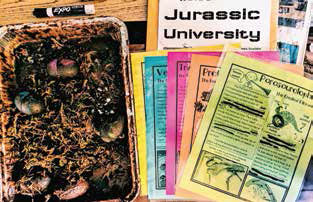
Multiple resources, including live video streaming, interactive games (Kahoots), and virtual field trips all contribute to creating these cross-curricular learning opportunities. Using the Ready program, for example, teachers can bring literacy lessons using scientific- and geography-based passages alive by showing videos from around the world.
The increased engagement among students is palpable. “We have seen low performing students who were apathetic about coming to school evolve into higher-performing students excited about learning,” says Vallo.
COLLABORATION AND PROFESSIONAL DEVELOPMENT ARE KEY
Tools and ideas to transform education. Sign up below.
“The cross-curricular initiative at St. Martin East sometimes leaves teachers struggling to know whether they are teaching standards to mastery level,” says Vallo. Encouraging teachers to plan with the end in mind, she says, in addition to providing time for teacher collaboration and increased teacher capacity in all areas of technology through PLCs, are essential. “Teacher ownership, exposure, and consistency are critical for success.”
KEY TOOLS THEY USE
ST. MARTIN EAST ELEMENTARY
► Chromebooks
► ClassDojo
► ClassFlow
► Flocabulary
► Google Classroom
► i-Ready
► iPads
► Lexia Learning
► Newsela
► Promethean boards
► Renaissance Learning AR
► Smart TVs
WORKING HARD AT THINKING HARD
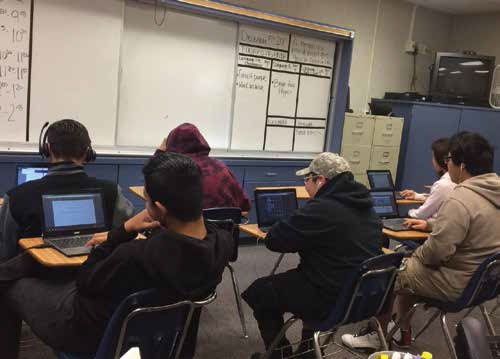
Thanks to Common Core, “students can’t just regurgitate what they read anymore,” says educational specialist Lisa Tanner. Even struggling students in Tanner’s special ed ELA classes at Walnut High School in Los Angeles County are learning to analyze, infer, reflect, extrapolate, discuss, and cite supporting text.
Tanner’s students benefit from two-class block periods, one of which is dedicated to individualized instruction using LANGUAGE! Live, an intensive intervention program for grades 5–12, and the other to direct instruction. It’s a comprehensive, research-based program, Tanner says, that teaches all the components of being a reader, writer, and thinker so that students have a deeper foundation for transitioning successfully into general education classes. With these gaps closed, many students are also able to access other cross-curricular classes like history and science.
BEYOND EXPECTATIONS
The literacy tools and strategies these students learn also give them the confidence necessary to achieve what they never thought possible. Because they’ve always found reading and writing such a struggle, many freshmen in Tanner’s classes have never thought of college as a realistic option. But when they take these key literacy skills into general education classes and realize they can be successful, many of them go on to complete two- and even four-year degrees.
KEY TOOLS THEY USE
WALNUT HIGH SCHOOL
► Big Ideas
►Chromebooks
► Google Classroom
► Kahoot!
► Khan Academy
► LANGUAGE! Fourth Edition
► Quizlet
► LANGUAGE! Live
BUILDING CONFIDENCE AND REASONING SKILLS
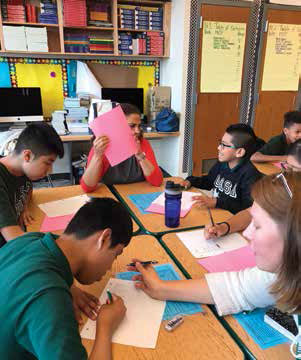
How can teachers make writing more “hands on” and engaging for students while also teaching them close reading strategies in all content areas? At Corona Arts & Sciences Academy (CASA) in New York City, where “literacy is the life blood of education,” Principal Beth Hert, Assistant Principal Amanda Gardener, teacher April Taitt, and team are in their third year of using ThinkCERCA with their Integrated Co-Teaching (ICT) classes. When students have authentic texts at their individual reading levels, “everyone has an entry point into the conversation.”
Current eighth graders in the CASA ICT class, who have been working on ThinkCERCA for three years now, demonstrate “an overwhelming build in confidence with both their use of technology and their written and oral work as opposed to classes who are not using the program.” While Hert and her team see many students “who support their claims but don’t successfully use their reasoning skills to synthesize and show how the evidence supports their work . . . it just seems more natural for these students to support their claims with evidence and reasoning.”
CASA teachers are being supported and encouraged to design cross-curricular lessons, such as a science/ELA collaboration exploring GMOs. In addition, CASA students have further opportunities to expand their cross-curricular learning through new coding and website design clubs.
LEARNING IN THE FISHBOWL
Since CASA is a new and growing school, it’s a challenge to get new staff up to speed every year without overwhelming them with “just one more thing.” So they’ve created “lab classrooms” led by more experienced teachers. ICT teams will float through these “fishbowls” this December to see the work in context and demystify its implementation before engaging in their next session of professional development. “We have found in our practice that showing versus telling makes the practice come alive,” Hert says
KEY TOOLS THEY USE
CASA
► BrainPOP
► Edperformance
► Engrade
► G Suite
► iPads
► Kahoot!
► Khan Academy
► Laptops
► MasteryConnect
► Newsela
► Plickers
► Promethean boards
► ThinkCERCA
THINKING, LEARNING, AND LEADING
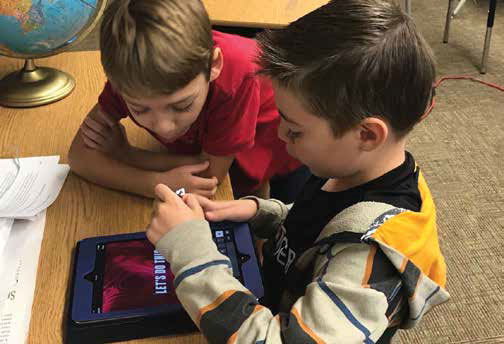
Creighton (AZ) Elementary School District aims to inspire students to be adventurous thinkers, collaborative learners, and kind-hearted leaders. A successful capital override recently enabled the district to significantly expand their technology integration and infrastructure, building on a strong foundation of pioneering work in technology and flipped instruction, says Director of Curriculum, Instruction, and Assessment Dr. Eric Dueppen.
Using tech-forward materials including McGraw-Hill Education’s Wonders (K–5) and StudySync (grades 6–8), the district is seeing increased reading achievement and engagement among all students. Students, particularly those in grades 6–8, are participating in deeper, more scholarly cross-curricular discussions sparked by engaging materials on current topics from StudySync TV and Blasts. Teachers are also finding these quality, vetted materials helpful for fostering discussions and supporting instructional design across the curriculum.
CURRICULUM AND IT PARTNERSHIPS
In any implementation, Dueppen says, it’s important to build an “interconnected, interdependent” team including both instructional and IT leaders. “They need each other very much,” he says. Other key components include a “focused but high-level vision and an open-ended process that encourages creativity but also formulates a clear plan with goals and benchmarks,” in addition to including student voice as much as possible.
“It’s important to ensure that layers of PD and time for teachers to learn about the technology and what it can do are built into the implementation timeline,” says Chief Academic Officer Dr. Sue Pederson. Integrating ISTE standards into ELA and math curriculum at all levels has also been key in helping the district determine how to leverage the power of technology to meet their goals.
COMMUNITY INVESTMENT AND INVOLVEMENT
At a recent Community Town Hall event co-led by students with Superintendent Dr. Donna Lewis, students shared examples of work they’ve done using technology. The conversations around the tables between community stakeholders and students, Dueppen says, “led to a deeper understanding of what’s happening in our district” and fostered leadership and relationships as these collaborative learners shared their knowledge.
KEY TOOLS THEY USE
CREIGHTON ESD
► Explain Everything
► G Suite
► Seesaw
► StudySync
► Wonders
SHOWCASING LITERACY AND CREATIVITY
THE CHALLENGE

Last year, the large and diverse Hillsborough County (FL) School District set out to create a literary event that would motivate students in over 225 schools and across all grade levels to read great books, to make cross-curricular connections by responding creatively to these books, and to use technology in meaningful and creative ways.
THE SOLUTION
An inclusive and representative cross-curricular team of people from across the district collaborated to create and plan the inaugural Student Literacy and Media (SLAM) Showcase. Students read books from grade-level Florida award nominated lists, created a diverse array of projects in the two different categories (2D and video creative expression), and presented them at their schools’ SLAM showcase events. Schools then selected representatives to bring their work to the district-wide Con-style event at the Tampa Convention Center.
We were building the plane as we flew it,” says Kimberly DeFusco, Supervisor, Library Media Services 6–12. Sharing and sparking ideas across the district, through PLCs and Twitter and other social media outlets, was key to the collaborative process of showing educators how they and their students could contribute to this event. As John Milburn, Supervisor, Library Media Services K–5, says, “You make the best plan you can and implement it—and then all of these other connections open up.” This year’s event adds a 3D category, which will further expand the creative possibilities to include, for example, sculpture, robotics, and 3D prints.
THE POWERFUL RESULTS
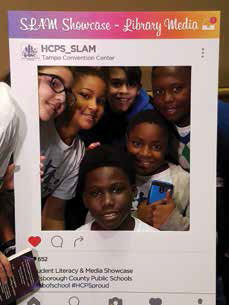
While art teachers, for example, immediately saw natural opportunities for cross-curricular connections as students used a variety of media to respond creatively, other connections weren’t as obvious at first. At Davidsen Middle School, the Computer Applications for Business class realized that, since they were already using Office Mix, they could create book trailers. At Blake High School, a public magnet arts school, TV and film production majors wrote, cast, and directed trailers “as if that book were a movie.” A fifth-grade student at Schwarzkopf Elementary created a stop-motion-animation trailer for a book she enjoyed using iMovie. Her project was tweeted, retweeted, and eventually reached the author—who loved it, came to the event, and met her young fan. These organic connections, particularly with authors who responded with excitement to students’ creations, created “a powerful symbiosis” that has surprised and delighted both DeFusco and Milburn. See more at bit.ly/SLAMWEB
KEY TOOLS THEY USE
HILLSBOROUGH COUNTY
► Animoto
► HP devices
► iMovie
► Movie Maker
► myON
► Office 365
► OneDrive
► OneNote
► PowerPoint
► PowToon
► Soundzabound
► Tinkercad
► Windows
PASSIONATE EXPERTS
Students in the rural South Central (NE) Unified School District may live an hour and a half from Lincoln and two and a half hours from Omaha, but thanks to innovative and thoughtful educational leaders, a supportive school board and community, over a hundred business partners, access to University of Nebraska resources, and 1:1 devices with an array of rich digital resources, the world comes to them. Opportunities for cross-curricular learning experiences and college and career preparation abound here, and a 100 percent college acceptance rate and improved test scores across the board are only part of the story.
CELEBRATING SUCCESS
Through the Learning in Depth (LiD) program, which promotes critical thinking and deep knowledge acquisition, each elementary-school student studies a topic throughout their time in elementary school. Paraprofessional Sharon Radabaugh says students connect a passion for reading—fiction and nonfiction texts across subject areas—to their passion for learning about these topics. At a recent event, elementary students introduced their topics to their grandparents, who gave them three to six more questions or ideas for further research.
Quarterly celebrations of student work have included a rock concert, trips to museums and the movies, and more. And students are responding with overwhelming enthusiasm. No less than 100 percent have met their Accelerated Reader 360 goals over the past year. A shy girl who exceeded her goal by 400 percent was nervous but proud to be able to participate on stage in a “magic of reading” show. Another student, who initially was not interested in learning about cells, is extracting DNA from strawberries.
EXPERTS IN THEIR FIELDS
High-school freshmen who choose to participate in the new NCAPS (Nebraska Center for Advanced Professional Studies) can choose from over 900 career options in nine different career pathways and develop a real-world project with a career mentor. Superintendent Randall Gilson explains that, with the goal of becoming an expert in their field, each student pursues this passion throughout high school following a design-thinking process. Students read, research, explore, and test their goals, culminating in a Shark Tank-like public presentation to parents, mentors, peers, and an industry panel.
Tools like Renaissance Learning enable students to read with purpose, develop problem-solving skills, innovate, and develop an entrepreneurial mindset. Students take charge of their learning and teachers integrate core curriculum with students’ individual projects. Many students graduate with career experience and connections, college courses completed, and a deep knowledge of the process of following their passion to become an expert.
KEY TOOLS THEY USE
SOUTH CENTRAL USD
► Adobe Creative Cloud
► Artsonia
► Basecamp
► CAD
► G Suite
► iPads
► MacBook Airs
► Renaissance Learning
► Scholastic’s Investigators
► Schoology
ALL BOOKS, ALL THE TIME
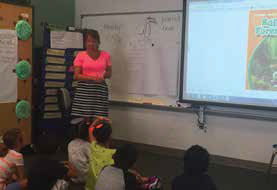
All students in the 114 elementary schools in the Wake County (NC) Public School System have 24/7 access to more than 11,000 leveled ebooks. Sherri Miller, Director of K–12 Literacy, says Big Universe gives teachers and students an incredibly rich resource of texts covering all topics in the curriculum, in a variety of genres. Big Universe addresses an important literacy shift, she says, as it “provides rich texts to allow students to read widely in text sets and build content knowledge around topics.”
Third graders attending summer camps as part of North Carolina’s Read to Achieve legislation, created around engaging topics like sports and animals, also find resources for independent reading and research. Miller is reaching out to community organizations such as the Y and Boys and Girls Clubs, where students spend time outside of school, to raise awareness that students with a connected device can log in and continue reading any time.
A PARTNERSHIP
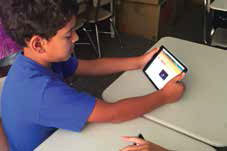
When Wake County adopted a new curriculum built on cross-curricular content, the OER EL Education, Miller turned to Big Universe for help. “They created our own Wake County bookshelves with texts around topics that align to the curriculum,” she says. “Students can go in and see their module bookshelf, and teachers can add to it. The resource provides students with texts at their fingertips to read independently at home and/or at school. Teachers can also use the texts within their instruction.”
THE DREAM
Miller’s vision is that one day every child waiting in a doctor’s office, at the laundromat, or in the car will reach for a parent’s device and, instead of a game, the book they’re reading will pop up. It will require a cultural shift, she admits, but the excitement being generated around reading at Wake County and other districts offers hope that dream could come true.
KEY TOOLS THEY USE
WAKE COUNTY
► Big Universe
► Chromebooks
► Discovery Education
► EL Education
► G Suite for Education
► iPad Minis
► NC Wise Owl
► SMART Boards
